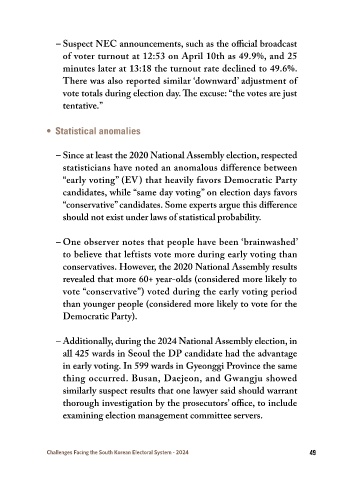Page 49 - Election Book-ENG
P. 49
– Suspect NEC announcements, such as the o"cial broadcast
of voter turnout at 12:53 on April 10th as 49.9%, and 25
minutes later at 13:18 the turnout rate declined to 49.6%.
There was also reported similar ‘downward’ adjustment of
vote totals during election day. !e excuse: “the votes are just
tentative.”
• Statistical anomalies
– Since at least the 2020 National Assembly election, respected
statisticians have noted an anomalous difference between
“early voting” (EV) that heavily favors Democratic Party
candidates, while “same day voting” on election days favors
“conservative” candidates. Some experts argue this di$erence
should not exist under laws of statistical probability.
– One observer notes that people have been ‘brainwashed’
to believe that leftists vote more during early voting than
conservatives. However, the 2020 National Assembly results
revealed that more 60+ year-olds (considered more likely to
vote “conservative”) voted during the early voting period
than younger people (considered more likely to vote for the
Democratic Party).
– Additionally, during the 2024 National Assembly election, in
all 425 wards in Seoul the DP candidate had the advantage
in early voting. In 599 wards in Gyeonggi Province the same
thing occurred. Busan, Daejeon, and Gwangju showed
similarly suspect results that one lawyer said should warrant
thorough investigation by the prosecutors’ o"ce, to include
examining election management committee servers.
Challenges Facing the South Korean Electoral System - 2024 49

